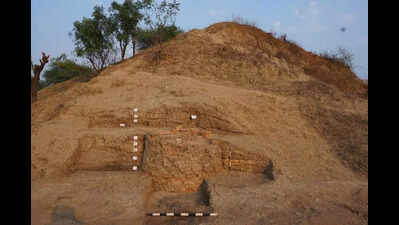- News
- Pachkhed in Vidarbha could be fulcrum of north-south Iron Age corridor
Pachkhed in Vidarbha could be fulcrum of north-south Iron Age corridor
Nagpur: Excavation of a prehistoric mound, spanning 250m x 70m, at the mouth of the meandering Chandrabhaga river, a tributary of Wardha river, at Pachkhed had unearthed a well-structured cultural sequence, including an iron smelting furnace with channels or shallow pans for molten heavy metal accumulation.
With confirmation of Iron Age commencement in Tamil Nadu approximately 5,300 years ago (3345 BCE), Pachkhed village in Babhulgaon tehsil of Yavatmal, 130km off Nagpur, is being touted as the fulcrum of the north-south Iron Age corridor, after excavations last year yielded proof of Iron Age patterns and documented brick wells from early times. An archaeological research team from Nagpur University is scouring for additional evidence to establish the early Iron Age settlements dating at the Vidarbha site.
According to earlier findings, the existence of the Iron Age in Vidarbha dates back to 1000 BCE, which is over 2,000 years after northern and southern sites. Experts believe there's no reason for ancient inhabitants of Vidarbha to be so late in use of iron.
Last year, a team led by Nagpur University professor, Prabash Sahu, excavated cultural deposits revealing early iron age settlements at Pachkhed. The postgraduate department of Ancient Indian History, Culture and Archaeology (AIHCA), led by Sahu, has now submitted a licence application to Archaeological Survey of India (ASI) to conduct fresh excavations at Pachkhed.
Dates of these remnants at Pachkhed await scientific establishment. However, following confirmation of Iron Age commencement in Tamil Nadu, AIHCA opted to gather additional evidence to establish the Iron Age settlement in Vidarbha. While northern sites indicate iron use around 1800 BCE, the primary source for dating Iron Age sites, namely the Megalithic sites in Vidarbha, shows it was around 1000 BCE.
"We will collect additional samples for scientific dating. Each aspect, whether geologically or botanically significant, would be examined alongside dating. Vidarbha's central position in the North-South corridor makes its chronological significance particularly intriguing," Sahu said.
The Interuniversity Accelerator Centre (IUAC) currently analyses eight samples from last year through accelerator mass spectrometry — a sophisticated technology for dating ancient remains. The eight samples submitted to IUAC by AIHCA researchers comprised burnt charcoal pieces, grains including rice, tur, wheat, and ber (Indian jujube). Botanical and geological studies on photolyte and sediments continue simultaneously. "Complete scientific data collation would enable comprehensive reconstruction of cultural and settlement patterns of the civilisation."
The Pachkhed mound was initially documented by Vilas Vahane from AIHCA in 2009. Sahu's team commenced excavations at the mound from February 2024, aiming to determine cultural sequence and comprehend early settlers through excavated artefacts.
End of Article
FOLLOW US ON SOCIAL MEDIA











